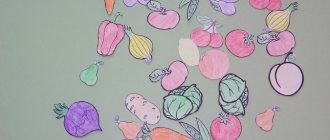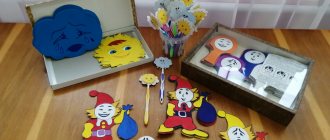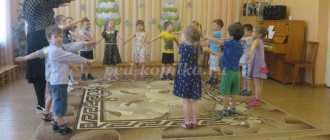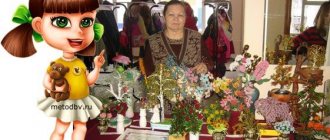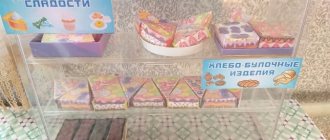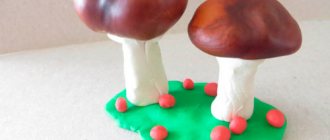MAGAZINE Preschooler.RF
Didactic game “Which tree is the leaf from?” (3-4 years)Goals of the game:
a) Didactic purpose:
- Expand children's understanding of trees
- Teach children to recognize by leaves and find different trees in the picture
- Clarify the names of trees and their parts
- Develop speech, attention, visual perception
- Enrich children's vocabulary with the names of trees and their fruits
- Develop fine motor skills of hands
b) Game goal:
- Play a didactic game
- Choose the right leaves for each tree
- Indicate the names of the trees to which the leaves are selected
Rules of the game:
— Number of players: from 1 to 7 people
— Game type: board
— The game continues until leaves for all the trees are found.
Attributes for the game:
— Cards with images of various trees: birch, chestnut, maple, etc.
— Chip cards with textile fasteners ( “Velcro” ) with images of leaves of different trees (correspond to tree cards)
Game actions and game content:
The game is played to consolidate knowledge of trees and their structure.
sticky chip cards , each of which corresponds to a specific tree.
There are two options for playing the game:
1) According to the lotto principle
The participants are given tree cards, and the presenter takes chips out of the box one after another, showing the leaves depicted on them. The player who discovers that the leaf fits his tree takes the chip and attaches it to his card. The first one to collect all the leaves and correctly name the tree wins. If there are more than two players, the game continues until there is only one loser left.
2) Independent game
Participants are dealt cards, and pre-mixed chips are laid out on the table. The players’ task is to independently find all the leaves for their tree and attach them to the card. The game is played “for a while” or for educational purposes - to consolidate the names of trees and their structure in memory, as well as learn to distinguish between different types of trees.
Game result:
— The teacher determines whether the child knows the names of trees, whether he can identify them from a picture, whether he names trees on cards and whether he knows what their leaves and fruits look like.
- It is indicated that the child played a didactic game, correctly/incorrectly matched the leaves to the tree, learned to identify trees from the image and name them.
| Next > |
Didactic game
Group:
4-5 years
Kind of activity
: didactic game.
Subject:
“What leaf.”
Educational area:
cognitive development, social and communicative development, speech development.
Forms of organization:
group, individual.
Didactic task
: improve children’s knowledge of distinguishing the leaves of three trees.
Game task
: tell the teacher about the leaves of the trees.
Game rules
: take a leaf out of the box, correctly name which tree the leaf is from, correctly name which leaf. Help each other in case of difficulties, do not interrupt each other.
Game actions
: naming which tree the leaf is from and which leaf.
Target:
development of curiosity and activity in the process of joint gaming activities.
Planned result:
- Show respect towards others.
- Show interest in gaming activities.
- Show curiosity and initiative.
- Demonstrate the ability to analyze and evaluate the achievement of a game goal.
- Demonstrate the ability to follow the rules of the game.
- Show knowledge about tree leaves (rowan, birch, apple tree).
- Demonstrate the ability to form adjectives from nouns.
| Tasks | Tasks taking into account the characteristics of the group’s students |
| Educational tasks :
Developmental tasks:
Training tasks:
| Sasha - teach how to form adjectives from nouns. Masha - to cultivate a respectful attitude towards others. |
Principles of preschool education (FSES):
1) building educational activities based on the individual characteristics of each child, in which the child himself becomes active in choosing the content of his education, becomes a subject of education (hereinafter referred to as individualization of preschool education);
2) assistance and cooperation of children and adults, recognition of the child as a full participant (subject) of educational relations;
3) supporting children’s initiative in various activities;
4) the formation of cognitive interests and cognitive actions of the child in various types of activities;
5) age adequacy of preschool education (compliance of conditions, requirements, methods with age and developmental characteristics).
Principles of education:
formation of a personal style of relationships with peers and teachers; creating a positive emotional background and an atmosphere of emotional uplift; education through interaction.
Abstract to the didactic game “Which tree is the leaf from? Circles of Lull"
Didactic manual “Which tree is the leaf from?”
Prepared by teacher: Zakharova Olesya Evgenievna
Relevance: During the walk, we noted that children of the middle group show increased interest in the world around them, in particular, in the trees and shrubs growing on the territory of our kindergarten; they notice that trees differ in the shape and size of leaves, fruits, seeds, cones , but cannot name them. For the purpose of getting to know each other and subsequently developing the ability to recognize and distinguish trees, we developed the following game.
Goal: - to develop children’s ability to recognize and name trees by their leaves, fruits, cones and seeds, to develop children’s visual memory and attention. Related goal: - actualization of colors and geometric shapes, expansion of children's environmental ideas.
Game progress: The game consists of two circles of different sizes, divided into 10 sectors, and 1 moving arrow. The sectors of the large circle depict entire trees, and the sectors of the small circle show their leaves, seeds, fruits and cones. Each sector of the large circle has a color image in the form of a geometric figure, which is duplicated on the sectors of the small circle. Thus, by rotating circles and matching these figures, children find matches (pairs) of a tree and its leaf. Age: 4-7 years. Number of players: 1-4. Game options and complication: At the first stage - when getting acquainted with the game - colored geometric shapes act as help; at the next stage, these shapes can be hidden.
Since our didactic game is similar to the “Circles of Lull” and has a plywood base, then, when changing pictures, it can be used to reinforce concepts in all areas of knowledge.
The invention “Circles of Lull” received its name in honor of the name of its creator - Raymond Lull (poet, philosopher, thinker, 13th century). In the 13th century, a French monk created a logical machine in the form of paper circles built according to ternary logic. Llull circles are a universal didactic tool that shapes the thinking processes of children and the development of intellectual and creative abilities in kindergarten. Lull circles introduce an element of play into classes and help maintain interest in the material being studied.
Llull circles are introduced to preschool children as wonderful rings or mysterious circles. 2-3 movable plywood circles of different diameters, covered with self-adhesive film, are strung on a common rod (bolt). There is a movable arrow on top. All circles are divided into the same number of sectors – 8-10. They contain a variety of pictures: subject, plot, words, numbers, figures, schematic images. The circle and arrow move freely. Anyone can get different combinations of pictures located on sectors and combine objects. To work with children 4–5 years old, it is advisable to take two circles of different diameters and use 4 sectors on each. When working with children 5-6 years old, two to three circles are used (6 to 8 sectors on each). Children aged 6-7 years can cope quite well with tasks that use three circles with 8 sectors on each.
This manual meets the requirements of the Federal State Educational Standard for Educational Education and will be useful to teachers of preschool institutions working with preschool children.
The manual complies with the principles of variability, safety and accessibility, is multifunctional, and is used in working with children in organized and independent educational activities, in special moments (in individual and subgroup lessons, play activities outside of classes, in independent play activities of children). The game options are plentiful as all games are designed for multi-purpose use. It all depends on the age, the tasks set, and the material covered by the children.
This guide can be used:
· to get acquainted with the outside world:
- acquaintance with living and inanimate nature, the properties of objects, their changes.
Di. “Which tree is the leaf from?”, “Who eats what and where does it live?”, “Name the object and its properties,” “Methods of movement,” “Methods of reproduction,” “Vegetables,” “Professions,” “Who eats what?” .
· on safety:
— consolidation of knowledge of road signs and traffic rules;
— consolidation of knowledge of environmental signs and rules of behavior in nature;
— consolidation of fire safety rules.
“Environmental signs”, “Road signs”, “Know the fire safety rules”, “We and nature”.
according to FEMP:
- strengthening the ability to find similarities and differences between objects;
- fixing the quantity, shape, color, size of objects.
“Color the objects”, “Big - small”, “One - many”, “How many”, “Which one?”
· on speech development:
- mastery of speech as a means of communication;
- strengthening the correct use of prepositions;
- ability to select adjectives and nouns;
- compiling stories, fairy tales, reasoning, discussions, etc.
“Choose a sound symbol”, “Choose a preposition”, “Come up with a sentence according to the diagram”, “Come up with a story”, “Explain an unusual combination”, “Guess a fairy tale”.
· on artistic and aesthetic development:
- development of creative abilities, ability to perceive and deeply
feel the beauty of nature;
— consolidation of knowledge about Russian folk traditions, holidays, native culture;
— consolidation of knowledge about folk art, folk and applied arts
art, folklore of Russia.
“What kind of vase”, “Find the animal by contour”, “Decorative and applied
art”, “Musical instruments”, “Professions of musicians”.
· in physical education:
“Name the game”, “What equipment”.
Game options:
D/i “Composing problems”
Educational area: “Cognitive development”.
Target:
strengthen the ability to compose and solve arithmetic problems.
Age: 6 – 7 years.
Materials and equipment:
Lull circles, addition and subtraction signs – 22 pcs., a set of numbers from 0 to 9 – 44 pcs., object pictures – 20 pcs.
How to play: Place object pictures on the bottom circle, numbers 1 or 2 with a sign for addition or subtraction on the middle circle, numbers from 1 to 9 on the top circle. Spin the circles and use the arrow to determine which problem to write. For example, the arrow showed: balls, +1, 6. Children create an addition problem about balls. “Masha had 6 balls. Dad bought another one. How many balls does Masha have?
Didactic game “What does a number consist of”
Educational field: "Cognitive development"
Goal: to consolidate the composition of a number from two smaller numbers.
Age: 6 – 7 years.
Material and equipment:
Llull circles, set of numbers from 0 to 9 – 44 pcs.
How to play: Place the numbers on all three circles. Use the arrow to select a number on the top circle, and use the numbers on the middle and bottom circle to find the composition of the number.
Didactic game “Who are the neighbors?”
Educational area:
"Cognitive Development".
Goal: learn to name the next and previous number.
Age: 6 – 7 years.
Material and equipment:
Llull circles, set of numbers from 0 to 9 – 44 pcs.
How to play: Place the numbers on all three circles. Use the arrow to select a number on the top circle, and use the numbers on the middle and bottom circle to find the neighbors of the selected number.
Didactic game “Find the figures”
Educational area:
"Cognitive Development".
Goal: to develop geometric vigilance in children, to consolidate the ability
determine what shapes an object is made of.
Age: 4 – 5 years.
Material and equipment:
Lull circles, geometric figures - 32 pcs., images of geometric figures - 16 pcs.
Progress of the game: We will arrange the images consisting of geometric figures on the lower ring, and separate geometric figures into the middle and upper rings. Using the arrow, select the image, then combine with it the geometric shapes on the middle and upper ring that it consists of.
Didactic game “Pick up a number”
Educational area:
"Cognitive Development".
Goal: to strengthen the ability to correlate numbers and quantities of objects.
Age: 5 – 6 years.
Material and equipment:
Lull circles, cards – 18 pcs.
How to play: We use two rings: large and medium. We put numbers on the middle ring, and pictures with objects on the bottom ring. Use the arrow to select a number. I invite the children to look at the number, name it correctly, then choose a picture on the bottom circle, the number of objects on which corresponds to this number.
Didactic game “What does it look like?”
Educational area: “Cognitive development”.
Goal: to teach children to correlate the shape of objects with known geometric figures.
Age: 4 – 5 years.
Materials and equipment: Lull circles, geometric figures – 8 pcs., object pictures – 35 pcs.
Game progress: We use two circles. We lay out subject pictures on the bottom circle,
on the middle one - geometric shapes. Using the arrow, we determine the geometric figure, then find pictures with similar objects in shape.
Didactic game “Continue the chain”
Educational area: “Cognitive development”.
Goal: develop logical thinking.
Age:
5 – 6 years.
Material and equipment: Lull circles, geometric shapes – 100 pcs.
How to play: Place cards with a chain of geometric shapes on the bottom ring, and individual geometric shapes on the middle and top ring. Use the arrow to select a card and continue the chain, turning the middle and top circle.
Didactic game “Where is the sound hidden?”
Educational field: “Speech development”.
Goal: improving sound analysis skills, literacy training,
expansion and activation of the dictionary.
Age: 6 - 7 years.
Materials and equipment: Lull circles, pictures of letters – 33 pcs., object pictures – 57 pcs.
Progress of the game: The game is played in pairs or with a subgroup of children. On the middle circle are letters, on the bottom circle are pictures. You need to match the letter to the picture and determine the position of the sound in the word. Children accompany all their actions with speech, consolidating the skills of sound analysis and acquired knowledge of literacy.
Didactic game “Make up a word.”
Educational area:
"Speech development".
Age:6 – 7 years.
Goal: improving the skills of syllabic analysis and synthesis,
literacy training, expansion and activation of vocabulary.
Materials and equipment: Pictures – 10 pcs., letters – 40 pcs.
Progress of the game: On the bottom circle there are object pictures, on the middle circle there is a syllable of letters with which the word begins. Children, spinning the circle, select the desired syllable for the object picture. Another option, on the bottom circle is a printed syllable and on the middle circle is a printed syllable. Children, spinning circles, form words from syllables.
Didactic game “Journey through fairy tales”
Educational field: “Speech development”.
Goal: to consolidate knowledge of fairy tales, the heroes of these fairy tales, to develop in children imagination, creative thinking, the ability to invent fairy tales, the ability to coherently and consistently present the course of an invented fairy tale. To cultivate the desire of children to participate in joint play activities, to strengthen the skills of collaboration between the teacher and children.
Age:
6 – 7 years old.
Material and equipment:
Llull circles, pictures – 24 pcs.
Progress of the game: Lay out the pictures: 1 circle - fairy-tale characters: Aladdin, Cinderella, Little Red Riding Hood, monster, Sleeping Beauty, Enchanted Frog, Puss in Boots, Geese-Swans
Circle 2 is the place where fabulous events take place: an Arab city, a king’s palace, a forest, an enchanted garden, a castle attic, a swamp, the Ogre’s castle, a hut on chicken legs. 3rd circle - objects: magic lamp, glass slipper, basket with pies, scarlet flower, spindle, arrow, boots, Ivanushka. Use the arrow to select a hero, rotating the middle and upper circles, pick up objects for him and the place where the fairy-tale actions take place. Complication: Spin the circles and the arrow, come up with a fairy tale based on the pictures that are under the arrow (for example, how Puss in Boots ended up in a hut on chicken legs with a scarlet flower).
Didactic game “Tree, leaf, fruit”
Educational area: «
Cognitive development".
Goal: ability to distinguish and name leaves and fruits of familiar trees;
develop speech, attention, observation, memory, promote the development of cognitive processes, broaden horizons, and cultivate aesthetic feelings.
Age: 6 – 7 years.
Materials and equipment: Lull circles, cards.
Progress of the game: The game introduces children to the trees of Russia. You can play alone or in a small group. Place images of trees on the bottom circle; on the middle circle - tree leaves; on the top - pictures of fruits or seeds (apple, pine cone, etc.). Children are asked to find matches on the circles. For example, select an image of an apple tree on the bottom circle, then, turning the middle circle, find the image of a leaf and place it above the apple tree; on the top circle, find an apple in the same way. They explain what happened.
Didactic game “Moms and their babies”
Educational area: “Cognitive development”, “Speech development”.
Goal: to consolidate the name of an adult animal and a cub, in the correct formation of the name of the cubs (plural), using the suffixes –onok-, -yonok-, -ata-, -yata-, -ok-; develop logical thinking and vocabulary.
Age: 4 – 5 years.
Materials and equipment: Lull circles, pictures – 60 pcs.
Progress of the game: The child uses an arrow to select an image of an adult animal on the bottom circle and names it correctly. Determines whether animals are domestic or wild. Then he rotates the middle circle, with pictures of one cub, and the top circle, with pictures of two cubs. Finds the desired picture, stops the circle, and correctly names a baby or several.
Didactic game “Types of Sports”
Educational area:
"Physical development".
Goal: consolidate knowledge about sports; learn to establish the simplest relationships between a sport and its attributes; develop the ability to speak correctly and completely, and actively use words on the topic “Sports Games” in speech; improve communication skills. Cultivate perseverance, patience, diligence.
Age: 4-5 years.
Materials and equipment: Lull circles, pictures – 20 – pcs.
Progress of the game: Place pictures with sports equipment on the middle circle, pictures with images of athletes in characteristic sportswear on the bottom circle (hockey player - stick and puck; gymnast - rings; football player - goal, soccer ball; basketball player - ring, basketball; etc. .d.) Rotating circles, match the pictures “Which of the athletes is involved in which sport.”
Didactic game “Pick the right sign”
Educational field: “Social and communicative development.”
Goal: to consolidate knowledge of traffic rules, knowledge of road signs, and teach thinking.
Age: 6 – 7 years.
Material and equipment:
Llull circles, pictures – 24 pcs.
Progress of the game: Bottom circle – pictures with traffic situations. The middle circle is pictures with road signs. The child selects a picture with a traffic situation using an arrow, describes it, rotates the middle circle and selects a sign that corresponds to the situation.
Educational effect:
Lull circles make it possible, by creating a relaxed and exciting atmosphere for the learning process, to make children's classes and free play activities exciting and effective.
In the process of working with the manual, children develop cognitive interest, curiosity, and creative activity. The child asks questions to adults and peers, is interested in cause-and-effect relationships, tries to invent and explain on his own, and is inclined to observe and experiment. The child is capable of making his own decisions, relying on his knowledge and skills in various activities.

